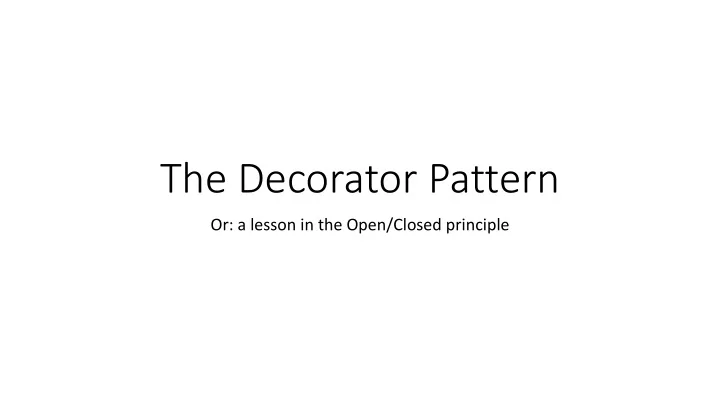

The Decorator Pattern Or: a lesson in the Open/Closed principle
How many times have we heard this phrase: “Favor composition over inheritance” ~some OOP guy who is smarter than I am The decorator pattern is another example of how composition can lead to more flexible and ultimately more maintainable class design.
Coffee Shop: Bad Class Design Beverage (abstract) Cost() HouseBlend DarkRoast Decaf Espresso Cost() Cost() Cost() Cost() What happens if we want add-ons like milk / soy milk / mocha?
Coffee Shop: Bad Class Design Permutations get out Beverage of hand – Class (abstract) Explosions! Cost() HouseBlend DarkRoast Decaf Espresso Cost() Cost() Cost() Cost() HouseBlendMilk DecafMilk EspressoMilk DarkRoastMilk Cost() Cost() Cost() Cost() HouseBlendSoy DarkRoastSoy DecafSoy EspressoSoy Cost() Cost() Cost() Cost()
Coffee Shop: Better Class Design Beverage -milk cost() in beverage is invoked -soy by each cost() override in subclasses – rigid design Cost() hasMilk() hasSoy() HouseBlend DarkRoast Decaf Espresso Cost() Cost() Cost() Cost()
Why is the last design still not optimal? • Price changes for add-ons force us to alter beverage class (existing code) • New add-ons force us to alter the cost calculation method in the superclass • New beverages will inherit condiment methods that might not be appropriate (i.e. why does Iced tea need mocha?) • What if you want more than one pump of mocha?
The Open/Closed Principle “Classes should be open for extension, yet closed for modification” ~Also some guy who is smarter than I am Goal is to allow classes to be easily extended to incorporate new behavior , without modifying existing code. The benefits of this are designs that are both resilient to change and flexible enough to meet changing requirements.
Decorator to the Rescue!
The Decorator Pattern: Class Diagram Abstract Component Abstract Decorator method1() method2() Concrete -Component wrappedObj Component method1() method1() method2() method2() Concrete Concrete DecoratorA DecoratorB - Private Object newState method1() method2() method1() Private newBehavior() method2()
Applying the Decorator Pattern Say we have a Pizza Shop : - Pizzas can be either Deep Dish or Thin Crust (cost different amounts) - Pizzas can have various toppings, like Pepperoni and Cheese - There are 4 different types of cheese: Mozzarella, Bleu, Cheddar, and Parmesean. They all cost different amounts. - We want to be able to calculate the price of each pizza that is made How would you apply the decorator pattern to design for this problem? Bonus: what if the prices also varied by the size of the pizza?
Abstract Class Pie abstract price() Abstract Class ToppingDecorator - Pie wrappedPie abstract price() Class Class DeepDish ThinCrust Class Class public price() public price() PepperoniDecorator CheeseDecorator - CheeseType ct Concrete Classes (Pie) public price() Private isSpicy() public price() Concrete Decorators
Applying the Decorator Pattern “Talk is cheap, show me the code!” ~Puxuan He https://github.com/bambielli/DecoratorExample
Limitations of Decorator • If you have code that relies on the concrete implementation’s type (i.e. DeepDish or ThinCrust) then Decorator will obscure that info from you. • Decorating your objects manually (like in my example) is a pain . • Combining decorators with the Factory or Builder patterns makes creating decorated objects much simpler and less prone to error! • It is *generally* against the mold of decorators to peak at other decorated layers to get more context • i.e. what if you wanted to know if the user ordered double pepperoni so you could print that out on their order? You’d have to know if the current pizza object is already wrapped by a pepperoni decorator. • Large numbers of small classes… harder to understand code
Decorators and Javascript
Decorators and Javascript • ES7 feature – allows decoration of both functions and classes
Decorators and Javascript • ES7 feature – allows decoration of both functions and classes • https://medium.com/google-developers/exploring-es7-decorators- 76ecb65fb841 ß Addy Osmani medium post on decorators (a bit old)
Decorators and Javascript https://github.com/jayphelps/core-decorators.js • Set of “core-decorators” that provide common annotations like: • Deprecate • ReadOnly • Enumerable • Mixin • Seems like JS decorators are still very much in flux , though • Originally supported by Babel 5, but no longer in Babel 6 • API for decorators is still being debated • Need to install babel-plugin-transform-decorators-legacy for support • That’s ok, though, since Javascript objects are built for composability out of the box J
Recommend
More recommend